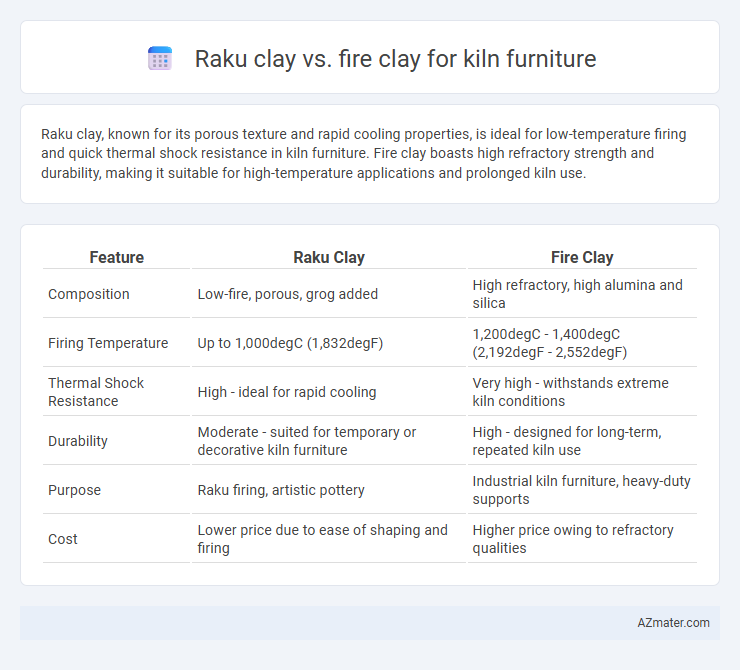Raku clay, known for its porous texture and rapid cooling properties, is ideal for low-temperature firing and quick thermal shock resistance in kiln furniture. Fire clay boasts high refractory strength and durability, making it suitable for high-temperature applications and prolonged kiln use.
Table of Comparison
| Feature | Raku Clay | Fire Clay |
|---|---|---|
| Composition | Low-fire, porous, grog added | High refractory, high alumina and silica |
| Firing Temperature | Up to 1,000degC (1,832degF) | 1,200degC - 1,400degC (2,192degF - 2,552degF) |
| Thermal Shock Resistance | High - ideal for rapid cooling | Very high - withstands extreme kiln conditions |
| Durability | Moderate - suited for temporary or decorative kiln furniture | High - designed for long-term, repeated kiln use |
| Purpose | Raku firing, artistic pottery | Industrial kiln furniture, heavy-duty supports |
| Cost | Lower price due to ease of shaping and firing | Higher price owing to refractory qualities |
Introduction to Raku Clay and Fire Clay
Raku clay is a porous, low-fire clay known for its thermal shock resistance, making it ideal for rapid heating and cooling cycles in raku firing. Fire clay, a high refractory clay with a high alumina content, withstands extreme kiln temperatures, providing durability and structural integrity for kiln furniture. Both clays serve distinct purposes in kiln operations, with raku clay suited for artistic raku firing and fire clay essential for high-temperature support components.
Understanding Kiln Furniture Applications
Raku clay offers thermal shock resistance and rapid cooling capabilities ideal for low-temperature, quick-firing Raku pottery, while fire clay excels in high-temperature durability required for sustained kiln firings and heavy-duty kiln furniture. Understanding kiln furniture applications involves selecting materials that match firing techniques; fire clay supports prolonged exposure to extreme heat, maintaining structural integrity in shelves and posts. Raku clay's porosity and flexibility make it suitable for delicate, flexible ware supports, optimizing performance without cracking under rapid temperature changes.
Composition and Properties of Raku Clay
Raku clay, typically composed of a blend rich in silica and low in fluxes, exhibits rapid thermal expansion and high porosity, making it ideal for the quick heating and cooling cycles of raku firing. In contrast, fire clay contains higher alumina and refractory materials, resulting in superior thermal shock resistance and structural strength for prolonged kiln use. The porous nature and lower firing temperature range of raku clay contribute to its distinctive crackle effects and ease of manipulation in kiln furniture applications.
Composition and Properties of Fire Clay
Fire clay, primarily composed of alumina and silica, exhibits high refractoriness, typically above 1600degC, making it ideal for kiln furniture subjected to extreme temperatures. Its dense structure ensures excellent thermal shock resistance and mechanical strength during repeated heating and cooling cycles. In contrast, Raku clay contains more fluxes and organic materials, resulting in lower refractoriness and reduced durability under prolonged kiln use.
Thermal Shock Resistance: Raku vs Fire Clay
Fire clay exhibits superior thermal shock resistance compared to Raku clay, making it more suitable for kiln furniture exposed to rapid temperature changes. Raku clay, typically used in raku firing processes, is more prone to cracking due to its lower thermal shock tolerance. The dense and refractory nature of fire clay allows it to withstand extreme thermal cycling without structural damage, essential for durable kiln shelves, posts, and supports.
Strength and Durability in High-Temperature Environments
Raku clay exhibits rapid thermal expansion and lower strength, making it less durable under repeated high-temperature firing cycles compared to fire clay. Fire clay, composed of refractory alumina and silica, offers superior strength and excellent thermal shock resistance, maintaining structural integrity in kiln furniture exposed to extreme heat. For kiln shelves and posts subjected to consistent high temperatures, fire clay provides enhanced durability and longer lifespan than Raku clay.
Cost Comparison: Raku Clay vs Fire Clay
Raku clay typically costs less than fire clay due to its lower firing temperature and simpler composition, making it a budget-friendly option for kiln furniture in low-fire applications. Fire clay is more expensive but justifies its price with superior durability and high-temperature resistance, crucial for intensive firing cycles in kiln furniture. Choosing between raku clay and fire clay depends on balancing initial material costs against long-term performance requirements in kiln furniture applications.
Suitability for Kiln Furniture Designs
Raku clay offers excellent thermal shock resistance, making it suitable for kiln furniture designs that require rapid heating and cooling cycles. Fire clay, known for its high alumina content and superior mechanical strength, provides durable support in high-temperature applications with prolonged firing schedules. Choosing between Raku clay and Fire clay depends on the specific firing conditions and structural requirements of the kiln furniture design.
Pros and Cons of Raku Clay for Kiln Furniture
Raku clay offers high thermal shock resistance, making it ideal for rapid heating and cooling cycles in kiln furniture. Its porous and lightweight structure supports effective heat distribution but can be more fragile and less durable over time compared to fire clay. While fire clay provides superior mechanical strength and longevity, Raku clay excels in applications requiring quick firing and easy handling.
Pros and Cons of Fire Clay for Kiln Furniture
Fire clay used in kiln furniture offers high thermal resistance and excellent durability at temperatures exceeding 1300degC, making it ideal for heavy-duty firing processes. Its main drawbacks include higher brittleness compared to raku clay, which can lead to cracking under rapid temperature changes, and increased weight, impacting handling and kiln load capacity. Fire clay's superior load-bearing capability and resistance to glaze adhesion make it a preferred choice for supporting dense or large ceramic pieces during firing.

Infographic: Raku clay vs Fire clay for Kiln furniture
 azmater.com
azmater.com